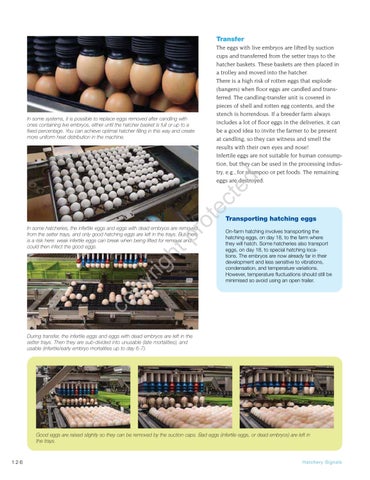Transfer The eggs with live embryos are lifted by suction cups and transferred from the setter trays to the hatcher baskets. These baskets are then placed in a trolley and moved into the hatcher. There is a high risk of rotten eggs that explode (bangers) when floor eggs are candled and transferred. The candling-transfer unit is covered in pieces of shell and rotten egg contents, and the stench is horrendous. If a breeder farm always includes a lot of floor eggs in the deliveries, it can be a good idea to invite the farmer to be present at candling, so they can witness and smell the results with their own eyes and nose! Infertile eggs are not suitable for human consumption, but they can be used in the processing industry, e.g., for shampoo or pet foods. The remaining eggs are destroyed.
pr ot
ec
te
d
In some systems, it is possible to replace eggs removed after candling with ones containing live embryos, either until the hatcher basket is full or up to a fixed percentage. You can achieve optimal hatcher filling in this way and create more uniform heat distribution in the machine.
On-farm hatching involves transporting the hatching eggs, on day 18, to the farm where they will hatch. Some hatcheries also transport eggs, on day 18, to special hatching locations. The embryos are now already far in their development and less sensitive to vibrations, condensation, and temperature variations. However, temperature fluctuations should still be minimised so avoid using an open trailer.
co
py
rig
ht
In some hatcheries, the infertile eggs and eggs with dead embryos are removed from the setter trays, and only good hatching eggs are left in the trays. But there is a risk here: weak infertile eggs can break when being lifted for removal and could then infect the good eggs.
Transporting hatching eggs
During transfer, the infertile eggs and eggs with dead embryos are left in the setter trays. Then they are sub-divided into unusable (late mortalities), and usable (infertile/early embryo mortalities up to day 6-7).
Good eggs are raised slightly so they can be removed by the suction caps. Bad eggs (infertile eggs, or dead embryos) are left in the trays.
126
Ha tc he ry S i gnal s








































































































